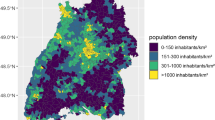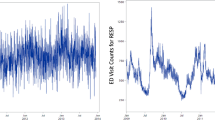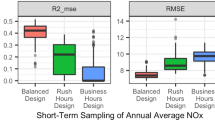Abstract
Numerous time series studies have reported associations between daily ambient concentrations of air pollution and morbidity or mortality. Recent personal exposure studies have also reported relatively high longitudinal correlation between personal exposures to particulate matter (PM) and home outdoor PM concentrations, lending support to the health effects reported in time series studies. However, the question remains as to how well the temporal fluctuations in the air pollution levels observed at an outdoor monitor represent the temporal fluctuations in the population exposures to pollution of outdoor origins in a city, and how such representativeness affects the size and significance of risk estimates. Also, such spatio-temporal correlations would vary from pollutant to pollutant, likely influencing their relative significance of statistical associations with health outcomes. In this study, we characterized the extent of monitor-to-monitor correlation over time among multiple monitoring sites for PM less than 10 μm (PM10), gaseous criteria pollutants, and several weather variables in seven central and eastern contiguous states (IL, IN, MI, OH, PA, WI, and WV) during the study period of 1988–1990. After removing seasonal trends, the monitor-to-monitor temporal correlation among the air pollution/weather variables within 100-mile separation distance in these areas could be generally ranked into three groups: (1) temperature, dew point, relative humidity (r>0.9); (2) O3, PM10, NO2 (r: 0.8–0.6); and (3) CO, SO2 (r<0.5). Using the subsets for separation distance less than 100 miles, regression analyses of these monitor-to-monitor correlation coefficients were also conducted with explanatory variables including separation distance, qualitative (land use, location setting, and monitoring objectives) and quantitative (large and small variance) site characteristics, and region indicators for Air Quality Control Region (AQCR). The separation distance was a significant predictor of monitor-to-monitor correlation decline especially for PM10 and NO2 (∼0.2 drop over 30 miles). Site characteristic variables were, in some cases, significant predictors of monitor-to-monitor correlation, but the magnitude of their impacts was not substantial. Regional differences, as examined by AQCR, were in some cases (e.g., in Metropolitan Philadelphia) substantial. In these areas, the pollutants that had generally poor monitor-to-monitor correlation in the overall seven states data (i.e., for SO2 and CO) showed higher monitor-to-monitor correlations, comparable with PM10 and O3, within the AQCR. These results are useful in interpreting some of the past time series epidemiological results. The differences in monitor-to-monitor correlations found across pollutants in this work (i.e., r∼0.8 vs. r∼0.4) are sufficiently large that they could be a factor in the different pollutant significance levels reported in the epidemiologic literature. It is recommended that future epidemiological studies collect and incorporate information on spatial variability among air pollutants in the analysis and interpretation of their results.
This is a preview of subscription content, access via your institution
Access options
Subscribe to this journal
Receive 6 print issues and online access
$259.00 per year
only $43.17 per issue
Buy this article
- Purchase on Springer Link
- Instant access to full article PDF
Prices may be subject to local taxes which are calculated during checkout
Similar content being viewed by others
Author information
Authors and Affiliations
Corresponding author
Rights and permissions
About this article
Cite this article
ITO, K., THURSTON, G., NÁDAS, A. et al. Monitor-to-monitor temporal correlation of air pollution and weather variables in the North-Central U.S.. J Expo Sci Environ Epidemiol 11, 21–32 (2001). https://doi.org/10.1038/sj.jea.7500144
Received:
Accepted:
Published:
Issue Date:
DOI: https://doi.org/10.1038/sj.jea.7500144
Keywords
This article is cited by
-
Characterizing air pollution patterns on multiple time scales in urban areas: a landscape ecological approach
Urban Ecosystems (2014)
-
Community-level spatial heterogeneity of chemical constituent levels of fine particulates and implications for epidemiological research
Journal of Exposure Science & Environmental Epidemiology (2011)
-
Comparison of different exposure settings in a case–crossover study on air pollution and daily mortality: counterintuitive results
Journal of Exposure Science & Environmental Epidemiology (2011)
-
The use of alternative pollutant metrics in time-series studies of ambient air pollution and respiratory emergency department visits
Journal of Exposure Science & Environmental Epidemiology (2011)
-
Characterization of PM2.5, gaseous pollutants, and meteorological interactions in the context of time-series health effects models
Journal of Exposure Science & Environmental Epidemiology (2007)



